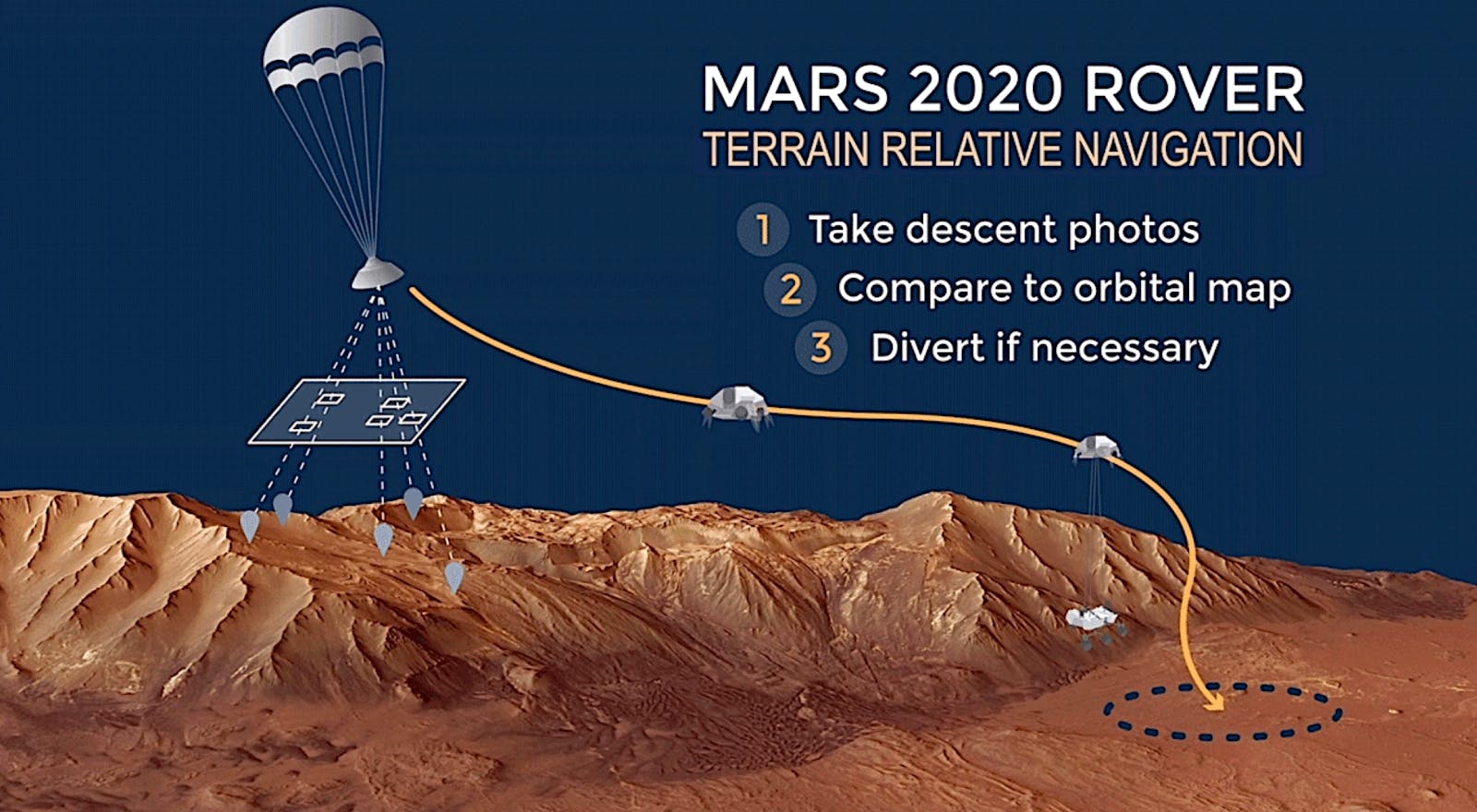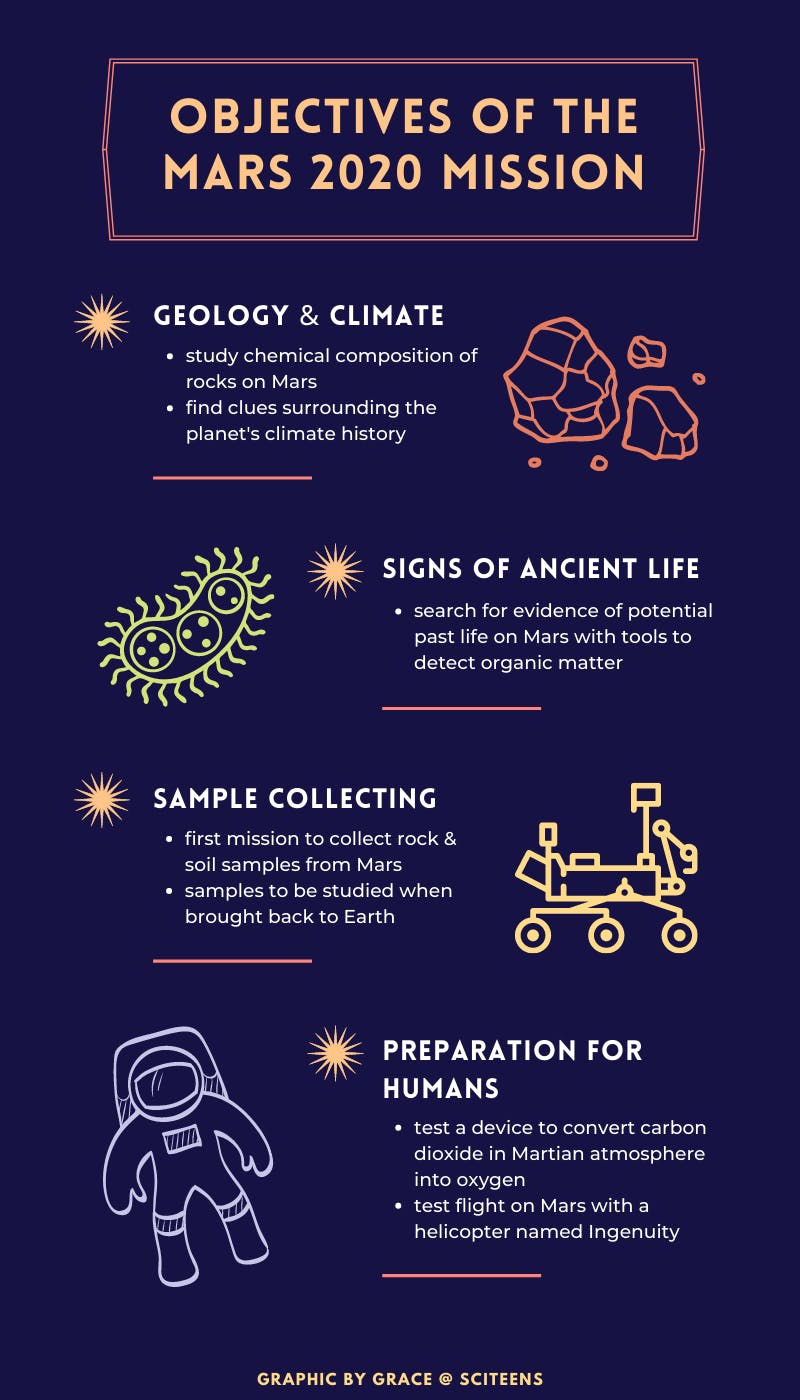Operation Perseverance: A Mars Rover’s Successful Landing
By Grace Jiang
February 24, 2021 · 5 minute read
Engineering
Mechanical Engineering
Space Science
Physics
Environmental Science
Seven months will pass. Three hundred million miles will be crossed. Traveling at speeds of up to 24,600 miles per hour, with cutting-edge technology packed into a space of 10 x 9 x 7 feet, NASA’s Perseverance Mars rover soars through outer space. Mission name? Mars 2020.
When was this Mars rover landing?
NASA’s Perseverance Mars rover was launched from Launch Complex 41 at Cape Canaveral Air Force Station, Florida, on July 30, 2020. This past Thursday, February 18, at around 4 PM EST, Perseverance landed successfully at its destination on Mars. NASA plans for Perseverance to spend at least one Mars year (~two Earth years) on Mars, exploring the Martian terrain.
Where was this Mars rover landing?
On Mars. Okay, jokes aside, Mars is pretty big. More specifically, Perseverance landed at the Jezero Crater landing site, a 28-mile wide crater on Mars, chosen specifically by NASA for its relatively high potential for discovering past life.
3.5 billion years ago, Jezero Crater was home to an ancient river delta, a place where a river flows into a large body of water like a lake. Scientists at NASA hope that by studying the riverbed, they may find traces of life on Mars.
How did this Mars rover land?
Landing the rover was no easy task for the team at NASA. In the past, only 50% of landing attempts on Mars have been successful, and the Mars 2020 mission was the most difficult Mars landing attempt yet. The Jezero Crater landing site is filled with more cliffs, pits, and rocks, than previous Mars landing sites, which isn’t exactly conducive to a smooth rover landing.
What’s more, it can take over 11 minutes for the Mars mission team on Earth to get a radio signal back from Mars, depending on Earth and Mars’s relative positions. This means by the time astronauts at NASA are informed that the rover has entered the Martian atmosphere, the rover has already landed on Mars. For this reason, the “entry, descent, and landing” phase of Mars missions is referred to as the “7 minutes of terror”: in the 7 minutes it takes for the rover to land after entering the Martian atmosphere, the mission team on Earth has no way of knowing what’s going on with the Mars rover. The rover must handle the entire landing procedure on its own.
Perseverance carries a new technology called “Terrain-Relative Navigation,” which allowed it to land at a site with rough terrain like Jezero Crater. This technology allows the rover to see its location over the surface of Mars by comparing photos taken during its descent to a map in its memory. The rover can then modify its trajectory accordingly when it comes across rough patches of terrain.

Why this Mars rover landing?
The Mars 2020 mission is centered around Astrobiology, a branch of science that deals with the origin, evolution, distribution, and future of life in the universe. In other words, NASA’s primary goal with this mission is to look into the potential of Mars as a planet for life.
The rover Perseverance is equipped with cutting-edge instruments to detect organic matter and determine the chemical composition of rocks on Mars. Scientists at NASA will be able to analyze the Red Planet’s geology in more detail than ever before. Detection of organic matter would be a sign of ancient life on Mars. With the study of Martian rocks, scientists will also be clued-in on the planet’s past climate. NASA is curious, how did Mars and Earth turn out so different if the two planets had started out so similar, both having liquid surface water and magnetic fields protecting them from solar radiation? Studying the geology and climate of Mars could give us answers.
Although previous missions have already confirmed the presence of water on Mars, this mission with the Perseverance rover will be unique in its goal to collect samples to bring back to Earth; other missions had solely focused on examining the planet’s surface. Perseverance has a drill capable of cutting away entire rock pieces, and it carries 38 empty tubes for sample collecting. If such samples are successfully brought to Earth, scientists at NASA would be able to analyze Martian rocks with sophisticated tools too complex to be actually brought to Mars.
Even if Perseverance doesn’t discover signs of past life, the Mars 2020 mission still paves the way for future human life on Mars. The rover carries a device that can produce oxygen from carbon dioxide in the Martian atmosphere; this will demonstrate a possible way future explorers will be able to breathe on Mars. Perseverance also carries Ingenuity, a small helicopter, to Mars alongside itself. Ingenuity aims to test man-powered flight in the thin Martian atmosphere. The first flight test is planned for this spring. If the flight is successful, we will unlock an aerial dimension of Mars for us to explore and potentially utilize.

What does this mean for the future?
History had already been made with the Perseverance rover’s landing, but that’s not the end of it: history is still being made. If all goes according to NASA’s plans, the future holds significant scientific discoveries and potentially huge surprises.
Definitely be on the lookout for raw photos taken by Perseverance on Mars!
Humans on Mars, a concept long-discussed, could become a reality in the future. We, the teenagers and young scientists of today, would be grown up by the time current scientists make significant scientific breakthroughs surrounding life on Mars. In the distant future, we could potentially play a role in the colonization of humans on the Red Planet.
Watch a highlight reel video of the successful rover landing:
References/Further Reading:
https://mars.nasa.gov/mars2020/
https://mars.nasa.gov/mars2020/mission/overview/
https://mars.nasa.gov/mars2020/mission/science/landing-site/
https://mars.nasa.gov/resources/25489/perseverance-rovers-entry-descent-and-landing-profile/
https://www.jpl.nasa.gov/news/press_kits/mars_2020/landing/
https://www.jpl.nasa.gov/news/press_kits/mars_2020/ingenuity/landing/
Did you enjoy this article?
About The Author
Grace Jiang is currently a senior at Pine View School. She loves many things, the most notable of which being ice cream, harp seals, bubble tea, and (of course!) science. Definitely contact her at grace@sciteens.org if you have any future article recommendations or just want to discuss life.